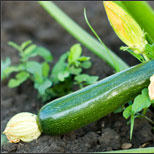How to Grow Amazing Zucchinis

Do you love zucchinis in the summer?
It has been a hot week all across the country. During the summer months, one popular vegetable that many home gardeners grow in their gardens is the zucchini. This versatile vegetable is sometimes called summer squash and can be consumed raw or cooked and are high in fiber and vitamins A and C.
Today, we are looking at how to grow zucchini. Zucchini is fairly easy to grow, but today we are going to share with you some tips to make it even easier. This summer squash is a favorite of many and can be used in breads, casseroles, and sauté over the stove.
Here are a few amazing tips to help you grow zucchini.
- Start with the soil
Make sure it is well drained and add a little compost to it. According to The University of Arizona Cooperative Extension,After the danger of frost has passed, seeds should be planted to a depth of 1 inch in light-textured, well-drained soil. Seed germination requires a minimum soil temperature of 60 degrees Fahrenheit. The preferred soil pH range is 6.0 to 7.5. Generally plants are spaced at a minimum of 3 feet from center; however in intensive gardening situations this can be reduced to 1 1/2 to 2 feet between plants.”
- Install Rootsticks
By installing Rootsticks with the zucchini plants, you will ensure the soil is moist and that the plant is getting the adequate water that is needed to flourish. Zucchini plants need to have moist, but you don’t want to over water causing the plant to become soggy. - Beware of potential diseases
Organic Gardening warns gardens to be aware of the possible diseases that zucchini can get such as:Powdery mildew may strike the plants, leaving whitish powdery spots on leaves that turn brown and dry. Plants that wilt and ooze a sticky sap when cut may be infected with bacterial wilt, which is spread by cucumber beetles.”
Organic Gardening provides a possible solution if your zucchini plants do suffer from powdery mildew. They suggest spraying leaves with baking soda (1 teaspoon in 1 quart water). This mixture raises the pH that creates an inhospitable environment for powdery mildew.
The next step is watching your zucchini grow, harvest, and enjoy!
What is your favorite way to use zucchini?



